Trying to figure out electric scooter laws from one state to another can feel like you're navigating a minefield. The short and sweet of it is that there is no single federal law governing e-scooters. Instead, everything from age limits and speed caps to helmet rules is decided at the state or even city level. This creates a real patchwork of regulations that can be tough to keep track of, a challenge shared by riders in the UK, EU, and Australia.
Your Quick Guide to State E-Scooter Rules
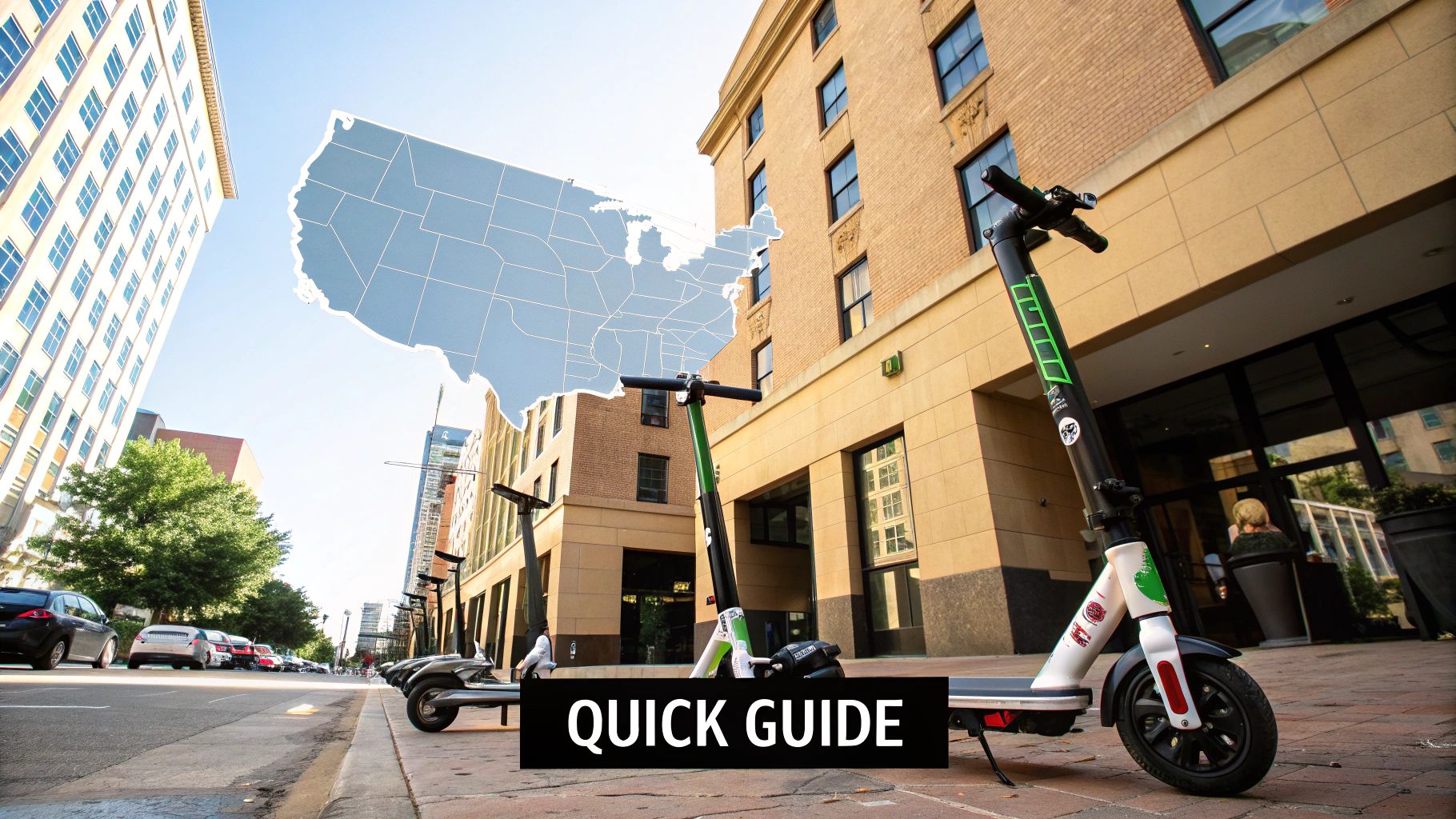
Let's be honest, untangling the web of e-scooter rules across the U.S. can be a major headache. In one state, your scooter might be treated just like a bicycle, but cross the border, and suddenly it's classified as a motorized vehicle with a whole new set of demands. This guide is here to cut through that confusion, focusing specifically on the US market.
This jumble of rules didn't happen by accident. It's the result of states scrambling to fit this new wave of personal transportation into their existing traffic laws, all while keeping people safe. As scooters exploded in popularity, lawmakers had to play catch-up, leading to some very different approaches. Some states welcomed them with open arms and minimal rules, while others hit the brakes with strict restrictions.
Why Laws Vary So Much
So, why the huge differences in electric scooter laws by state? It really boils down to local priorities and what the streets actually look like. A packed city crisscrossed with bike lanes is going to have a completely different take on things than a sprawling suburb with wide-open sidewalks.
A few key things are always on lawmakers' minds:
- Public Safety Concerns: The number one goal is keeping riders, pedestrians, and drivers from crashing into each other. Simple as that.
- Traffic Flow: Rules are often put in place to stop scooters from clogging up sidewalks or slowing down car traffic.
- Encouraging Alternative Transport: On the flip side, some states make their laws friendly to promote greener ways of getting around.
At this point, over 40 states have put some kind of e-scooter regulation on the books, which shows a clear move toward making things official. But the results are all over the map. For instance, Delaware has outright banned them on public roads, while Connecticut gives riders the green light to go up to 20 MPH with no license needed. This is exactly why checking the local rules before you ride is non-negotiable. You can get a great overview of these state-by-state variations at World Population Review.
To give you a quick snapshot before we get into the nitty-gritty of each state, here’s a table highlighting the rules in a few key places.
Quick Reference E-Scooter Laws Snapshot
This table offers a quick side-by-side look at how different states handle the most common e-scooter rules. It's a great starting point for understanding just how much things can change from one state to the next.
| State | Minimum Age | Helmet Required (Under Age) | Max Speed (MPH) | Sidewalk Riding |
|---|---|---|---|---|
| California | 16 | 18 | 15 | Prohibited |
| Florida | 16 | 16 | 15 | Permitted |
| New York | 16 | 18 | 15 | Varies by city |
| Texas | 16 | 18 | 20 | Varies by city |
| Illinois | No state | No state requirement | 15 | Permitted |
As you can see, the rules aren't just different—they're wildly inconsistent. This makes it crucial to know the law wherever you plan to ride. Now, let's dive into the detailed breakdown for each state.
Understanding Core E-Scooter Regulations
Before we dive into the state-by-state specifics, it’s helpful to get a handle on the kinds of rules you'll run into. Most e-scooter laws across the country are built from the same few ingredients, and once you know what they are, making sense of your local ordinances gets a whole lot easier.
These regulations are all about striking a balance—giving riders the freedom to get around while keeping everyone safe. Think of it as a playbook for integrating scooters into the daily flow of traffic without creating a total free-for-all. Every state just picks and chooses a slightly different combination of these rules.
Common Categories of E-Scooter Laws
Most of the time, the laws you’ll need to know cover your age, what gear you need, and where you’re actually allowed to ride. The fine print changes from place to place, but the basic ideas are pretty universal.
Here are the main things to keep an eye out for:
- Age Restrictions: You'll almost always find a minimum age to ride, which is usually 16 years old. This is to make sure riders are mature enough to navigate traffic safely.
- Helmet Laws: Lots of states require helmets, particularly for riders under 18. It’s a no-brainer, really, since head injuries are the biggest risk in any scooter spill.
- Speed Limits: States put a cap on how fast you can go to protect riders, pedestrians, and drivers alike. You'll typically see limits between 15 and 20 MPH.
- Permitted Riding Zones: This is a huge one. Local laws dictate whether you can be on the sidewalk, in a bike lane, or on the road itself. This rule can change drastically even from one town to the next.
This infographic gives you a great visual snapshot of how these rules differ across the United States.
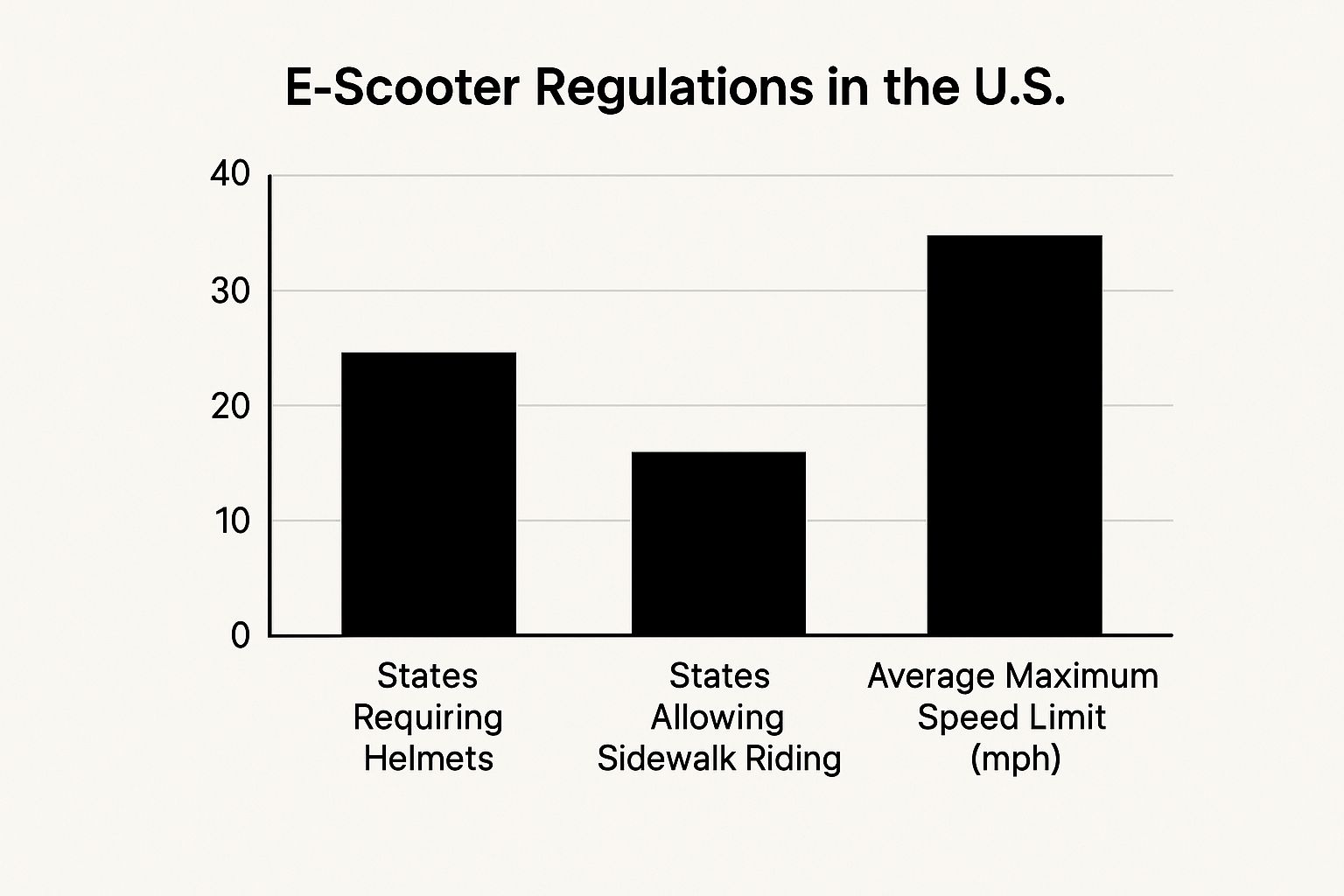
As you can see, speed limits are pretty consistent, but there's a huge divide on things like sidewalk riding and helmet requirements. Getting the local laws down is one thing, but for a complete picture, check out our guide on essential electric scooter safety tips to make sure you’re riding smart. Knowing the rules and the best practices is what responsible riding is all about.
Your A-Z Guide to E-Scooter Laws in Every State
Alright, let's get into the nitty-gritty. This is where you'll find the most complete breakdown of electric scooter laws for all 50 states. Forget digging through confusing legal jargon—we've laid it all out for you here, state by state.
We've organized each entry to give you a quick, at-a-glance look at the rules you actually need to know. Think minimum age to ride, helmet laws, speed limits, and where you're allowed to scoot. This setup makes it easy to check the rules in your hometown or get up to speed before you ride in a new state.
Alabama to Hawaii
Right off the bat, this first group of states perfectly illustrates just how different the rules can be. You’ve got states like Alabama with a pretty relaxed attitude, and then you have California, which has some of the strictest regulations in the country. It’s a perfect example of why you can't assume the rules are the same everywhere.
Here’s the breakdown for the first batch of states:
- Alabama: Generally, e-scooters are treated just like bicycles here. There are no statewide rules forcing you to wear a helmet or be a certain age, but individual cities can—and often do—make their own rules. The default speed limit is 15 MPH.
- Alaska: State law is pretty quiet on e-scooters, which puts them in a bit of a legal gray area. Because of this, it's the local towns and cities that call the shots. Anchorage, for instance, has specific rules for its shared scooter programs, so you absolutely have to check local ordinances.
- Arizona: You don't need a driver's license to ride an e-scooter in Arizona. While the state doesn't have a universal helmet law, cities like Tucson and Yuma require them. You’re good to go in bike lanes, but whether you can ride on the sidewalk depends entirely on the city you're in.
- Arkansas: You need to be at least 16 years old to ride here. If you're under 21, a helmet is mandatory. The state also caps your speed at 15 MPH.
- California: Welcome to one of the most regulated states for scooting. You must have a driver's license or a learner's permit, be at least 16 years old, and wear a helmet if you're under 18. The speed limit is a non-negotiable 15 MPH, and riding on sidewalks is a hard no, statewide.
- Colorado: E-scooters get classified pretty much like bikes. You can hit a top speed of 20 MPH and ride in bike lanes. As for sidewalks, it's generally a no-go unless a local law specifically allows it.
- Connecticut: The state officially defines what an e-scooter is and sets the max speed at 20 MPH. You won't need a driver's license, but local governments get to decide the rules for riding on sidewalks and in bike lanes.
- Delaware: This one's a bit of a surprise—state law actually prohibits e-scooters on any public roads, highways, or sidewalks. Riding is pretty much restricted to private property.
- Florida: E-scooters get the same treatment as bicycles. You have to be at least 16 to ride one on a public road, and anyone under that age must wear a helmet. Sidewalk riding is usually allowed, but you have to yield to people on foot.
- Georgia: You can ride on roads and in bike lanes, but keep your speed at or below 20 MPH. You'll need to be 16 or older, and stay off the sidewalks.
- Hawaii: The state hasn't made any specific laws for electric scooters, so it's up to the individual counties to regulate them. Honolulu, for example, has its own rules, especially for scooter-sharing companies.
What This Means for You: Just look at the difference between California's strict rules (licenses, no sidewalks) and Florida's more laid-back, bike-centric approach. It really drives home the point that you have to know the local law before you ride. This guide is your starting point.
Idaho to Montana
As we continue down the list, you'll see the same pattern emerge. Some states have put a lot of thought into their e-scooter laws, creating very specific rules. Others have taken a more hands-off approach, leaving it up to local communities to figure things out.
- Idaho: The state lumps e-scooters in with "toy vehicles," which means they're not typically allowed on public roads. The exception is when a local city or town passes its own ordinance to allow and regulate them.
- Illinois: You can ride on roads where the speed limit is under 35 MPH. The state caps scooter speed at 15 MPH, but lets local governments make the final call on sidewalk use.
- Indiana: Riders need to be at least 15 years old. The speed limit is a little higher at 20 MPH, and you're welcome in bike lanes. Sidewalks, however, are generally off-limits.
- Iowa: There are no specific statewide laws for e-scooters, which leaves them in a legally fuzzy space. All the rules are set at the city or county level.
- Kansas: Scooters are permitted on streets and in bike lanes, with a max speed of 20 MPH. You must be at least 16 years old to hop on.
- Kentucky: No state-level laws here, so local rules are the only ones that matter. Major cities like Louisville have set up their own pilot programs with specific regulations.
- Louisiana: The state treats e-scooters like bicycles. That means no statewide mandates for helmets or a minimum age, but always be on the lookout for local rules.
- Maine: You're allowed on roads with a speed limit of 35 MPH or less and in bike lanes. Your top speed is capped at 15 MPH.
- Maryland: You have to be 16 or older to ride. The top speed is 20 MPH, and you can generally ride anywhere a bicycle can.
- Massachusetts: The minimum age to ride is 16. Helmets are required for riders under 18, and the speed limit is 20 MPH.
- Michigan: The law here talks about "electric skateboards," allowing them on most roads with a speed limit of 25 MPH or less.
- Minnesota: You need to be 18 or older to use a rental scooter, but strangely, state law is silent on an age limit for privately owned ones. The max speed is 15 MPH.
- Mississippi: No specific state laws exist. Regulation is entirely up to local cities and towns.
- Missouri: Much like Mississippi, there's no statewide framework. Cities like St. Louis and Kansas City have their own set of rules you'll need to follow.
- Montana: E-scooters are treated just like bicycles, with no specific state-level rules on age or helmets.
As we go through the rest of the states, we'll keep filling in the map, giving you a complete picture of the electric scooter laws by state across the entire country.
Now, for a quick-reference tool, we’ve put together a comprehensive table that boils all this information down.
Comprehensive State-by-State E-Scooter Law Matrix
Sometimes you just need the facts, fast. This table is designed for exactly that. It's a quick, scannable overview of the most critical e-scooter laws in all 50 states, letting you compare regulations at a glance.
| State | Minimum Rider Age | Helmet Law Details | Statewide Max Speed | Sidewalk Riding Permitted? | License Required? |
|---|---|---|---|---|---|
| Alabama | None Statewide | None Statewide | 15 MPH | Varies by City | No |
| Alaska | None Statewide | None Statewide | Varies by City | Varies by City | No |
| Arizona | None Statewide | Required in some cities | 20 MPH | Varies by City | No |
| Arkansas | 16 | Required for riders under 21 | 15 MPH | Prohibited | No |
| California | 16 | Required for riders under 18 | 15 MPH | Prohibited Statewide | Yes (Permit OK) |
| Colorado | None Statewide | None Statewide | 20 MPH | Varies by City | No |
| Connecticut | 16 | None Statewide | 20 MPH | Varies by City | No |
| Delaware | N/A | N/A | N/A | Prohibited | N/A |
| Florida | 16 | Required for riders under 16 | Varies by City | Generally Yes | No |
| Georgia | 16 | None Statewide | 20 MPH | Prohibited | No |
| Hawaii | Varies by County | Varies by County | Varies by County | Varies by County | No |
| Idaho | Varies by City | Varies by City | Varies by City | Varies by City | No |
| Illinois | None Statewide | None Statewide | 15 MPH | Varies by City | No |
| Indiana | 15 | None Statewide | 20 MPH | Generally No | No |
| Iowa | Varies by City | Varies by City | Varies by City | Varies by City | No |
| Kansas | 16 | None Statewide | 20 MPH | Varies by City | No |
| Kentucky | Varies by City | Varies by City | Varies by City | Varies by City | No |
| Louisiana | None Statewide | None Statewide | Varies by City | Varies by City | No |
| Maine | None Statewide | None Statewide | 15 MPH | Varies by City | No |
| Maryland | 16 | None Statewide | 20 MPH | Varies by City | No |
| Massachusetts | 16 | Required for riders under 18 | 20 MPH | Varies by City | No |
| Michigan | None Statewide | None Statewide | 25 MPH | Varies by City | No |
| Minnesota | 18 (for rentals) | None Statewide | 15 MPH | Varies by City | No |
| Mississippi | Varies by City | Varies by City | Varies by City | Varies by City | No |
| Missouri | Varies by City | Varies by City | Varies by City | Varies by City | No |
| Montana | None Statewide | None Statewide | Varies by City | Varies by City | No |
| Nebraska | 16 | None Statewide | 20 MPH | Generally No | No |
| Nevada | 16 | None Statewide | 20 MPH | Varies by City | No |
| New Hampshire | 16 | Required for riders under 16 | 20 MPH | Prohibited | No |
| New Jersey | 16 | Helmets "encouraged" | 19 MPH | Prohibited | No |
| New Mexico | 18 | Required for all riders | 15 MPH | Prohibited | No |
| New York | 16 | Required for riders under 18 | 15 MPH | Varies by City | No |
| North Carolina | 16 | None Statewide | 15 MPH | Varies by City | No |
| North Dakota | 14 | Required for riders under 18 | 20 MPH | Varies by City | No |
| Ohio | 16 | None Statewide | 20 MPH | Varies by City | No |
| Oklahoma | 16 | None Statewide | 15 MPH | Varies by City | No |
| Oregon | 16 | Required for riders under 16 | 15 MPH | Prohibited | No |
| Pennsylvania | 16 | None Statewide | 25 MPH | Prohibited | No |
| Rhode Island | 16 | Required for riders under 16 | 20 MPH | Varies by City | No |
| South Carolina | None Statewide | None Statewide | Varies by City | Varies by City | No |
| South Dakota | 14 | Required for riders under 18 | 15 MPH | Generally Yes | No |
| Tennessee | 16 | Required for riders under 18 | 20 MPH | Varies by City | No |
| Texas | 16 | None Statewide | 20 MPH | Varies by City | No |
| Utah | 15 | None Statewide | 15 MPH | Varies by City | No |
| Vermont | 16 | Required for all riders | 20 MPH | Prohibited | No |
| Virginia | 14 | None Statewide | 20 MPH | Generally Yes | No |
| Washington | 16 | None Statewide | 15 MPH | Generally Yes | No |
| West Virginia | 15 | Required for riders under 15 | 20 MPH | Prohibited | No |
| Wisconsin | 16 | None Statewide | 20 MPH | Varies by City | No |
| Wyoming | None Statewide | None Statewide | Varies by City | Varies by City | No |
Remember, this matrix is a fantastic starting point, but "Varies by City" is a cue to do a quick local search. City ordinances can add extra layers to these state laws, so always double-check if you're riding in a major metro area.
How City Ordinances and Campus Rules Change Everything
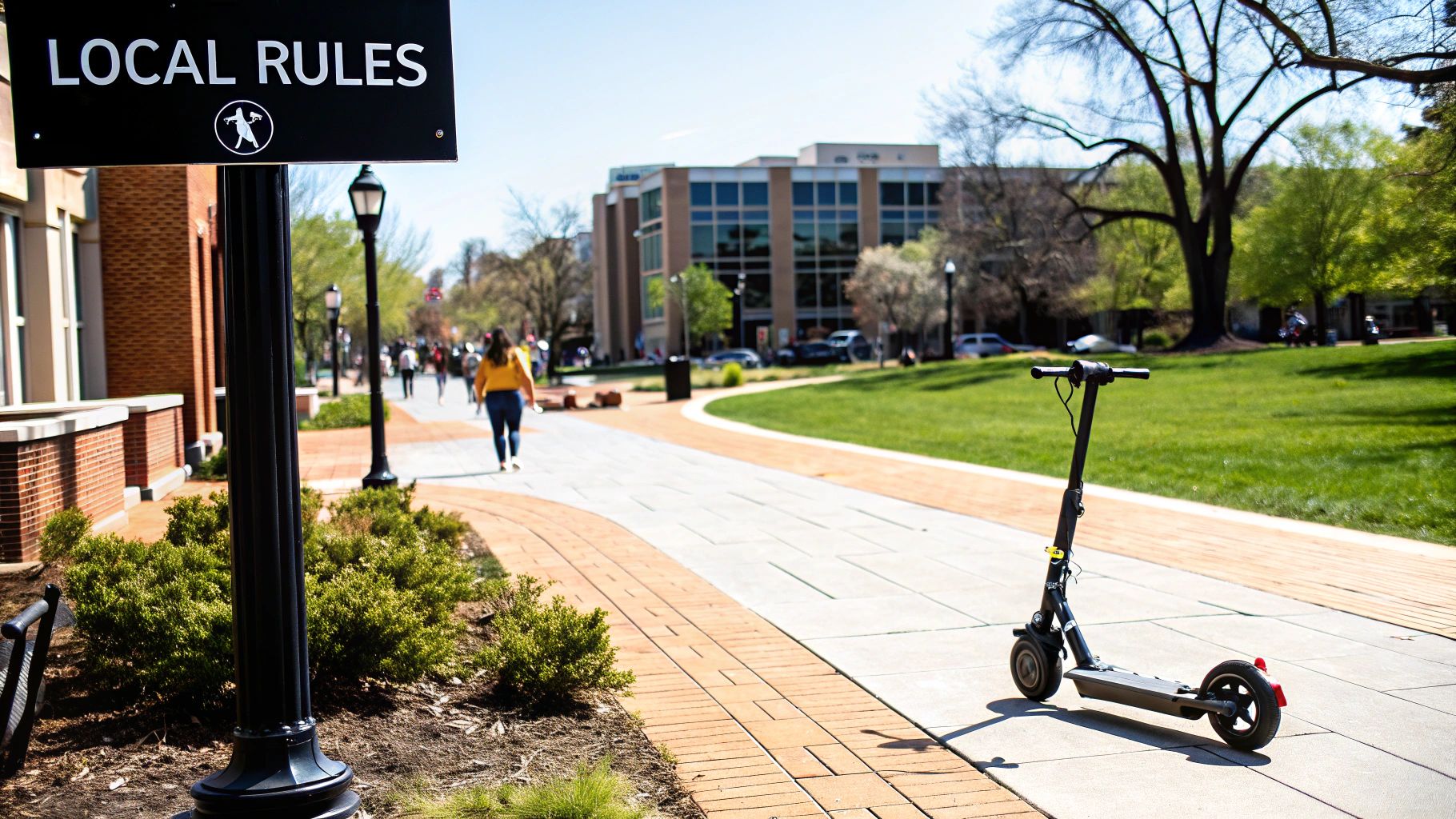
While our state-by-state guide gives you a great starting point, the rulebook for electric scooters can change the second you cross city limits. It’s best to think of state laws as the big picture, but it's the cities and towns that write the fine print. This is where you’ll run into hyper-local rules that can trip up even the most careful riders.
Lots of municipalities use their own ordinances to deal with specific local issues, like congested downtown areas or busy boardwalks. For example, a state might be perfectly fine with a 20 MPH speed limit, but a city like Santa Monica could knock that down to 15 MPH on its streets and enforce even slower speeds in designated "slow zones."
Local Rules Can Override State Law
If there's one thing to remember, it's this: a city or county can almost always set stricter regulations than the state. These local laws are designed to fit the unique flow of traffic and pedestrian life in that specific community, so knowing them is critical.
Here are a few common examples you'll run into:
- No-Ride Zones: Busy entertainment districts or historic squares might be completely off-limits. Austin, for instance, uses geofencing to create no-ride zones around its popular Sixth Street area during peak hours, all in the name of pedestrian safety.
- Lower Speed Limits: High-traffic spots, like beach paths or city parks, often have speed limits way below the statewide cap.
- Parking Regulations: To stop sidewalks from turning into a scooter graveyard, many cities have set up designated parking corrals. Leave your scooter outside one of these, and you could be looking at a fine.
These local tweaks are a big piece of the puzzle when we talk about what urban mobility means for today's cities. It’s all about figuring out how to make new ways of getting around fit safely into the places we already live.
One of the biggest mistakes riders make is assuming the state law is the final word. The truth is, a city can ban sidewalk riding even if the state allows it. Always check the local government or police department website for the most current rules.
Don't Forget College Campuses
University campuses are a whole different ballgame. They often act like mini-cities with their own public safety departments and traffic regulations. To manage the thousands of students zipping around, many universities have cooked up their own detailed electric scooter policies.
These campus-specific rules might include:
- Complete Bans: Some schools just say no, prohibiting personal electric scooters anywhere on campus property.
- Designated Parking: Just like in cities, a lot of campuses require you to park scooters only in specific racks or zones to keep pathways clear.
- Pedestrian-Only Zones: The central part of a campus might be a "dismount zone," meaning you have to get off and walk your scooter.
Before you ever ride on or through a university, do yourself a favor and check its transportation or campus police website. A quick search can save you from a nasty surprise and a ticket from campus security.
How US Scooter Laws Compare to Europe and Australia
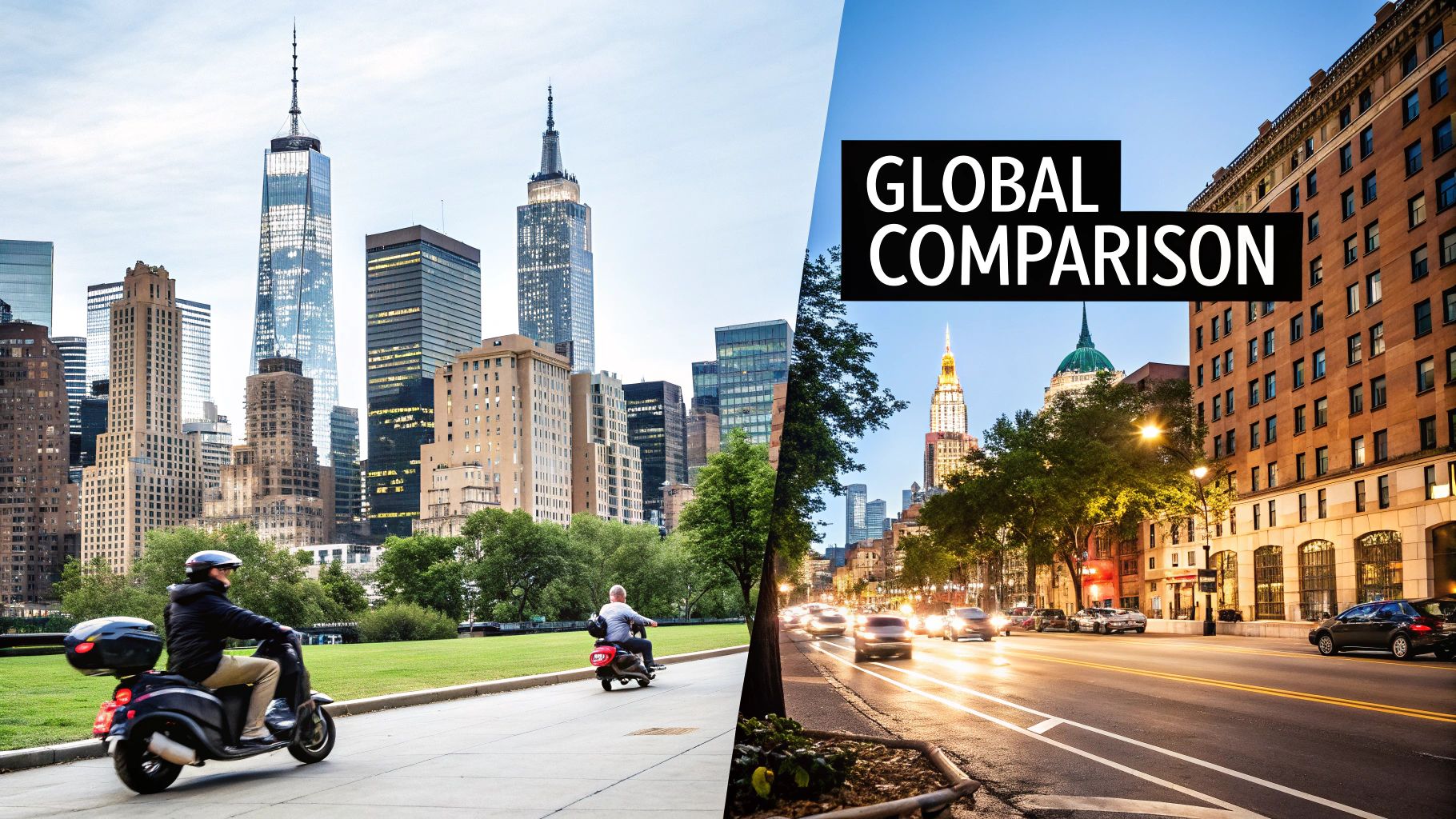
While this guide zeroes in on the patchwork of electric scooter laws by state here in the US, it's worth taking a quick look at how American rules stack up against other major markets like the UK, EU, and Australia. The growing pains of fitting micromobility into cities aren't just an American problem. Cities all over the globe are wrestling with the same challenge: how to keep things convenient without compromising public safety.
Seeing what's happening internationally helps put our own debates into perspective. The conversations happening in places like California and Florida are part of a much bigger, global discussion. From London to Sydney, lawmakers are trying to figure out the exact same things.
European E-Scooter Regulations
Europe went all-in on e-scooters pretty early, so they've had a bit more time to experiment with different legal frameworks. In many EU countries, scooters fall into a special category called "Personal Light Electric Vehicles," which comes with its own set of rules.
You'll find a few common threads running through most European regulations:
- Speed Caps: Most countries draw the line at 20-25 km/h (that's about 12-15.5 MPH).
- Riding Zones: Sidewalks are almost always a no-go. Riders are pushed into bike lanes or onto streets where car traffic is slower.
- Age and Safety Gear: You typically have to be at least 14 to 16 to ride, and while helmet rules can be all over the map, they're often mandatory for younger riders.
Big cities like Paris and Berlin, for example, have gotten really specific with designated parking areas and strict speed limits to get a handle on the scooter chaos. The UK has been more cautious, primarily allowing e-scooters through government-approved rental trials in select cities. For a great overview of this trend, NCSL.org has a good breakdown of how states are creating these laws.
How Australia Handles E-Scooters
Down Under, the approach is a lot like in the US—it's handled state-by-state. The key difference is that Australia has generally been a bit more cautious. Some states give the green light to privately owned e-scooters (with tight speed limits, of course), while others are only dipping their toes in with shared rental programs under strict trial conditions.
For example, in Queensland, you can cruise at up to 25 km/h on paths and roads. But in New South Wales, the government has historically been much tougher on private scooter use, showing a more hesitant attitude toward embracing micromobility.
Looking at what's happening around the world makes one thing clear: nobody has found the "perfect" answer just yet. It also shows that the legal maze in the US is just one piece of a global movement to build smarter, safer, and more efficient cities. Speed is a huge part of that equation, and you can learn more in our guide on the electric scooter speed limit and how it's being handled.
Got Questions About E-Scooter Laws? We've Got Answers.
Even after you've looked up your state's main e-scooter laws, a few specific questions always seem to pop up. You might know the speed limit, but what about the grey areas? Let's dive into some of the most common questions riders ask so you can navigate those tricky situations with confidence.
Getting these little details right can be the difference between a great ride and an expensive ticket, so it's worth knowing the specifics.
Do I Need Insurance For My Own Electric Scooter?
For the most part, no. Most states don't require you to carry liability insurance for a personal e-scooter. The general rule of thumb is, if you don't need it for a bicycle, you probably don't need it for your scooter.
That said, it's a good idea to check your current homeowner's or renter's insurance. Some policies actually cover personal property like an e-scooter, which could be a lifesaver if it gets stolen or damaged. If you're a heavy-duty city commuter, you might even consider a separate, specialized policy for that extra peace of mind.
Can I Actually Get a DUI on an Electric Scooter?
Yes, 100%. This is one thing every single rider needs to take seriously. In just about every state, driving under the influence (DUI/DWI) laws aren't just for cars—they apply to anyone operating a motorized vehicle, and that almost always includes e-scooters.
And don't think the penalties are any lighter. The consequences can be just as severe as getting a DUI in a car, including:
- Hefty fines that can easily climb into the thousands of dollars.
- Losing your driver's license, even though a car wasn't involved.
- Possible jail time, depending on where you are and the specifics of the situation.
The takeaway here is simple: if you've been drinking, don't even think about hopping on your scooter. It's just not worth the risk to your safety or your legal record.
Are The Rules Different For Rental Scooters vs. My Own?
While the local traffic laws apply to everyone, rental companies like Lime and Bird have their own set of rules you have to play by. When you sign up for their app and start a ride, you're agreeing to their specific user agreement.
These company rules often go beyond state law and can include:
- Tougher Age Limits: Most rental companies require you to be 18 or older, even in states where the legal age to ride is lower.
- Specific Parking Zones: Their apps will often dictate exactly where you can and can't park your scooter to end a trip.
- Geofenced "No-Ride" Zones: You might find the scooter automatically slows to a crawl or shuts off completely if you enter a restricted area.
If you ignore these company-specific rules, you could get hit with a fine directly from them or even get booted from their service for good.
Ready to hit the road with confidence? At Punk Ride LLC, we offer a curated selection of top-tier electric scooters that blend style, performance, and sustainability. Find your perfect ride and make your city travel effortless and eco-friendly. Explore our collection at https://www.punkride.com.




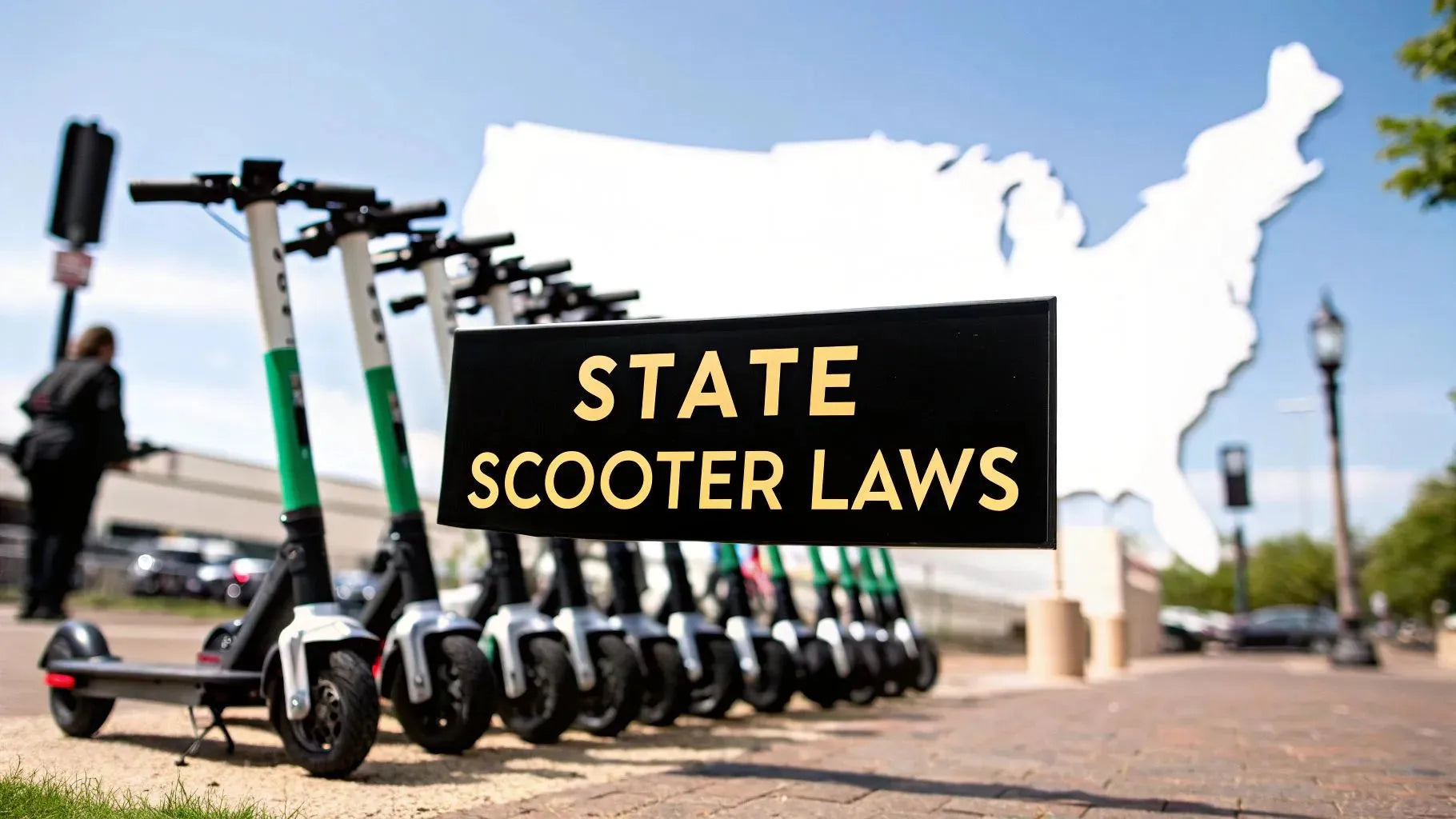
Share:
Are Electric Bikes Street Legal? Your Guide to the US & Australia
Electric Scooter Law California Explained